Instead of creating your own button, just move the build in button according to the action bar size.
This code works for me and the button is just where the button should be (like in google maps):
// Gets the my location button
View myLocationButton = getSherlockActivity().findViewById(R.id.MainContainer).findViewById(2);
// Checks if we found the my location button
if (myLocationButton != null){
int actionBarHeight = 0;
TypedValue tv = new TypedValue();
// Checks if the os version has actionbar in it or not
if(Build.VERSION.SDK_INT >= Build.VERSION_CODES.HONEYCOMB){
if (getSherlockActivity().getTheme().resolveAttribute(android.R.attr.actionBarSize, tv, true))
actionBarHeight = TypedValue.complexToDimensionPixelSize(tv.data,getResources().getDisplayMetrics());
}
// Before the action bar was added to the api
else if(getSherlockActivity().getTheme().resolveAttribute(com.actionbarsherlock.R.attr.actionBarSize, tv, true)){
actionBarHeight = TypedValue.complexToDimensionPixelSize(tv.data,getResources().getDisplayMetrics());
}
// Sets the margin of the button
ViewGroup.MarginLayoutParams marginParams = new ViewGroup.MarginLayoutParams(myLocationButton.getLayoutParams());
marginParams.setMargins(0, actionBarHeight + 20, 20, 0);
RelativeLayout.LayoutParams layoutParams = new RelativeLayout.LayoutParams(marginParams);
layoutParams.addRule(RelativeLayout.ALIGN_PARENT_RIGHT, RelativeLayout.TRUE);
myLocationButton.setLayoutParams(layoutParams);
}
Just put this code in the onActivityCreated (if you will put it in the onCreateOptionsMenu, it will not support version before 3.0 - because the life cycle there is different.
Another thing, the "R.id.MainContainer" is the container of the map fragment.
I'm using ActionBar Sherlock, but it will work also for regular action bar with a few modifications..
